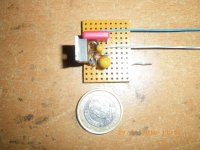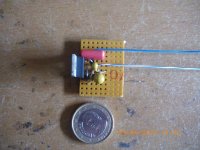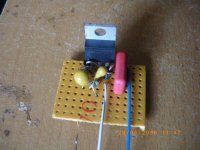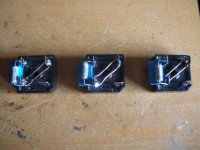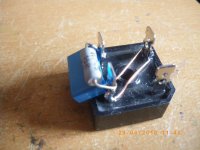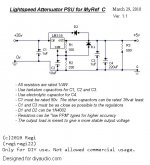Guys,
I have a few questions in my emails from you and I will get to them today. I have been kitting and avoiding the computer ( can you believe it, zero computer!) the entire weekend. Its been nice. Sonidos came over with his family for Saturday and we kitted nearly every minute from 9am to midnight. Done? No. Not nearly. He is planning another trip.
I am kitting this morning as well.
Its stressful, but its fun to. I know it sounds easy, plug in the parts, get them shipped and put them in boxes right? Yeah, no! So we have a few short parts which have either been on the way or just got ordered a minute ago. For instance I ordered half as mayn 1k 2W than I should so that got ordered a few minutes back.
So we have a few short parts which have either been on the way or just got ordered a minute ago. For instance I ordered half as mayn 1k 2W than I should so that got ordered a few minutes back.
I ordered a huge amount of LDRs a week and a half ago but had one demand of Allied " Get them out of one single bag". Its important for matching quality. They contacted the factory and is requesting the quantity directly off of the line and drop shipped from the factory. If you ordered LDRs I dont think there will be a delay but its possible. Wont be much though. Remember the baby is due at the end of May and there is no way I am going to have anything left to ship by then.
So anyway, things are going well and when the extra Wima, LM318, relays, heatsinks, and resistors get here the kits wont be far behind.
Glad to see you guys discussing and researching the circuit so much. I really think this circuit deserves the attention. After speaking with the Caddock engineer I am confident that the Caddock will be fine. The new heatsink is 6.4W. I have checked the distributors and manufacturers website to confirm. Maybe it is thicker material. I know for sure it is taller than the old one. We have built hundreds of these boards and the experimentation continues. The particular buy is based on the experience of Dario and Tom. They used MUR820 and 1N4001. Hundreds of others have used 1N4001 and they work. Dario might be right that they might inject a little noise backwards. I think someone should experiment and report back. But removing them, from the kits and ordering another bunch of diodes then kitting them in is not going to happen in this GB. I dont plan on changing any more parts.
Uriah
I have a few questions in my emails from you and I will get to them today. I have been kitting and avoiding the computer ( can you believe it, zero computer!) the entire weekend. Its been nice. Sonidos came over with his family for Saturday and we kitted nearly every minute from 9am to midnight. Done? No. Not nearly. He is planning another trip.
I am kitting this morning as well.
Its stressful, but its fun to. I know it sounds easy, plug in the parts, get them shipped and put them in boxes right? Yeah, no!
I ordered a huge amount of LDRs a week and a half ago but had one demand of Allied " Get them out of one single bag". Its important for matching quality. They contacted the factory and is requesting the quantity directly off of the line and drop shipped from the factory. If you ordered LDRs I dont think there will be a delay but its possible. Wont be much though. Remember the baby is due at the end of May and there is no way I am going to have anything left to ship by then.
So anyway, things are going well and when the extra Wima, LM318, relays, heatsinks, and resistors get here the kits wont be far behind.
Glad to see you guys discussing and researching the circuit so much. I really think this circuit deserves the attention. After speaking with the Caddock engineer I am confident that the Caddock will be fine. The new heatsink is 6.4W. I have checked the distributors and manufacturers website to confirm. Maybe it is thicker material. I know for sure it is taller than the old one. We have built hundreds of these boards and the experimentation continues. The particular buy is based on the experience of Dario and Tom. They used MUR820 and 1N4001. Hundreds of others have used 1N4001 and they work. Dario might be right that they might inject a little noise backwards. I think someone should experiment and report back. But removing them, from the kits and ordering another bunch of diodes then kitting them in is not going to happen in this GB. I dont plan on changing any more parts.
Uriah
Thank you very much Uriah for all the work you are doing, and the time you are sacrifacing from staying with your family.
Please don't get stressed or worried, take all the time you need to pack the kits. Better safe than sorry, and this is not a work you are being paid for.
Talking about deliveries, I am receiving tomorrow my Farnell order with the trafo (finally a single 2x25vac 250VA), the components for the Lightspeed regulator and some other parts (sockets, RCA connectors and so...)
Please don't get stressed or worried, take all the time you need to pack the kits. Better safe than sorry, and this is not a work you are being paid for.
Talking about deliveries, I am receiving tomorrow my Farnell order with the trafo (finally a single 2x25vac 250VA), the components for the Lightspeed regulator and some other parts (sockets, RCA connectors and so...)
OHHHH that reminds me. You guys should pickup some sockets. Only if you want to play with different resistors and caps to hear different sound. Anyway, thats they way Tom and Dario played with different sounds to come up with this BOM. That way you dont solder, unsolder, solder, unsolder, solder... whoops pad came off!
I was thinking about that this weekend. Searching for "socket" on digikey or mouser isn't very useful... anyone have a part number?OHHHH that reminds me. You guys should pickup some sockets. Only if you want to play with different resistors and caps to hear different sound. Anyway, thats they way Tom and Dario played with different sounds to come up with this BOM. That way you dont solder, unsolder, solder, unsolder, solder... whoops pad came off!
506-510-AG90D (Mouser)
BTW the right keyword for search is 'SIL socket'

BTW the right keyword for search is 'SIL socket'
Thank you very much Uriah for all the work you are doing, and the time you are sacrifacing from staying with your family.
Last edited:
International
Dear Uriah,
No pressure but the international shipping button doesn't show up on the buildyouramplifier.com site yet.
Just a gentle reminder in case you need the shipping payments sooner.
Thanks for all your hard work, and thanks to Sonidas for helping out with kitting up.
Cheers
Bill
Dear Uriah,
No pressure but the international shipping button doesn't show up on the buildyouramplifier.com site yet.
Just a gentle reminder in case you need the shipping payments sooner.
Thanks for all your hard work, and thanks to Sonidas for helping out with kitting up.
Cheers
Bill
Not much time for fun, but
the wife and I and our 2 little ones had a great time at Uriah's home. They all went off to see Annie and Uriah and I dug into all those parts. All those red resistors are still burned into my retinas!!
We took a break and we went to the store to pick up some treats and I bought a beer for my wife and I to share. A great way to end the night after hours of work.
Well, we were working so intently, I forgot about the beer. Ouch!
But that tells you how much I love this hobby and goes back to when I was a small boy looking at the inside of my Dad's portable record player with tubes. It was my pleasure to help out Uriah and you guys. And the last 2 nights, I have had that beer. All is good.
And the last 2 nights, I have had that beer. All is good.
the wife and I and our 2 little ones had a great time at Uriah's home. They all went off to see Annie and Uriah and I dug into all those parts. All those red resistors are still burned into my retinas!!
We took a break and we went to the store to pick up some treats and I bought a beer for my wife and I to share. A great way to end the night after hours of work.
Well, we were working so intently, I forgot about the beer. Ouch!
But that tells you how much I love this hobby and goes back to when I was a small boy looking at the inside of my Dad's portable record player with tubes. It was my pleasure to help out Uriah and you guys.
International shipping is 15 for each pair of amps. If you ordered 4 amps, buy International shipping two times, etc.
Canadian Shipping is 8 for each pair of amps. If you ordered 4 amps, by Canadian shipping two times, etc.
Its up on Uriah Dailey
Canadian Shipping is 8 for each pair of amps. If you ordered 4 amps, by Canadian shipping two times, etc.
Its up on Uriah Dailey
Pictures of Lightspeed PSU for MyRef_C
Well, I have finished the PSU I will be using to integrate the Lightspeed attenuator that Uriah kindly offered to us at a very reduced price in the kit.
I managed to fit it in...an square centimeter! It's amazing how small you can make a regulator. You just have to take +35v from any of the MyRef_C boards. Attached is the schematic.
It may seem a bit messy and filthy, but it works as a charm, steady and clean voltage. It has a very robust construction, and being light can be directly attached to a big heatsink and hold it just hanging. Blue wire is input, white wire is output ant the bare grey is ground.
Another thing I have finished are the GROUND BREAKING devices. I am very concerned about electrical security, so I REFUSE to keep untied protective earth and GND from the amp. Just imagine what will happen if the live from the mains hangs out and touch an RCA socket. You will have 220v on the RCA; not really my concept of security. Especially if you have kids around with their (sometimes) wet fingers and their unavoidable neccesity to touch everything they see.
I have used this little devices in other designs, and they work really well. Here in the link you have a technical explanation, but resuming it, the diodes will not conduct if voltage is not at least the diode breakdown voltage. So, in a non-failure situation, diodes will not conduct and the capacitor will allow to pass ONLY high frecuency interference, thus allowing the case to act as a RF shield. The resistor will mantain PE and ground tied, but reducing circulating currents caused by ground loops to a minimum.
In case of failure, like the example with the RCA, the diode bridge will allow high current faults to pass, thus tripping the breaker from the house electrical panel, and derivating those currents to earth.
Earthing (Grounding) Your Hi-Fi - Tricks and Techniques
Well, I have finished the PSU I will be using to integrate the Lightspeed attenuator that Uriah kindly offered to us at a very reduced price in the kit.
I managed to fit it in...an square centimeter! It's amazing how small you can make a regulator. You just have to take +35v from any of the MyRef_C boards. Attached is the schematic.
It may seem a bit messy and filthy, but it works as a charm, steady and clean voltage. It has a very robust construction, and being light can be directly attached to a big heatsink and hold it just hanging. Blue wire is input, white wire is output ant the bare grey is ground.
Another thing I have finished are the GROUND BREAKING devices. I am very concerned about electrical security, so I REFUSE to keep untied protective earth and GND from the amp. Just imagine what will happen if the live from the mains hangs out and touch an RCA socket. You will have 220v on the RCA; not really my concept of security. Especially if you have kids around with their (sometimes) wet fingers and their unavoidable neccesity to touch everything they see.
I have used this little devices in other designs, and they work really well. Here in the link you have a technical explanation, but resuming it, the diodes will not conduct if voltage is not at least the diode breakdown voltage. So, in a non-failure situation, diodes will not conduct and the capacitor will allow to pass ONLY high frecuency interference, thus allowing the case to act as a RF shield. The resistor will mantain PE and ground tied, but reducing circulating currents caused by ground loops to a minimum.
In case of failure, like the example with the RCA, the diode bridge will allow high current faults to pass, thus tripping the breaker from the house electrical panel, and derivating those currents to earth.
Earthing (Grounding) Your Hi-Fi - Tricks and Techniques
Attachments
I forgot to say that, as you can see, I have made small variations in the selected components. Input bypass cap is not a tantalum one, but a polyester one. Just because it was hanging around my closet.
I have not used an electrolytic in the output. Two main reasons:
-It may not be neccesary. As the datasheet from the regulator says, it doesn't need more than 1uF tant or film at the output to perform well. Do we really need that amount of capacitance to supply 4 leds, plus some resistors voltage drops? After all, it is a 5A (with 12A current peak :O ) regulator, a device made to provide current without dropping voltage. I think it will cope with the current demands. This way, I can avoid some of the called "electrolytic distortion".
-Space wise. I wanted it to be very small. Though, an electrolytic won't take up to much space...
I have not used an electrolytic in the output. Two main reasons:
-It may not be neccesary. As the datasheet from the regulator says, it doesn't need more than 1uF tant or film at the output to perform well. Do we really need that amount of capacitance to supply 4 leds, plus some resistors voltage drops? After all, it is a 5A (with 12A current peak :O ) regulator, a device made to provide current without dropping voltage. I think it will cope with the current demands. This way, I can avoid some of the called "electrolytic distortion".
-Space wise. I wanted it to be very small. Though, an electrolytic won't take up to much space...
You are right Andrew, we don't really need a high wattage resistor. In a normal usage it will produce very few heat. And in fault condition, resistor doesn't matter as all of the current will pass through the diode bridge. The same happens with the capacitor.
Maybe making the cap bigger than 0.1uF will have a lower HF attenuation, thus making it more effective?
Maybe making the cap bigger than 0.1uF will have a lower HF attenuation, thus making it more effective?
Regi,
They will want to be careful that their regulator tab is either well insulated or NOT attached to the heatsink as it may interact with the LM3886 if THAT is improperly insulated from the sink.
Since the max that will ever be flowing though this circuit is about 40mA then a 30V drop will actually get that regulator pretty hot. Sinking is a necessity when the LDRs are at max and min volume. Any other volume and this is not a problem, but obviously we will use these settings so there will need to be sinking and it will need to be safe.
Another thing to consider is the on/off switch of the LDRs. If we dont use a switch then the LDRs will power up when the amp is turned on. Fine since there is a delay while the relay decides to kick in and during that delay the LDRs will hit their desired settings. However when we turn it OFF we want to make sure that the LDRs turn off AFTER the amp does because if the shunt LDRs go high resistance before the amp decides to turn off (capacitance will keep it going) then we get max volume for a second or two. It would be annoying. So we could put a diode from the amps power supply + to the regulator and then after the regulator give it a decent sized capacitor so that we get some extra time on the LDRs. Yes, we could simply connect to the amps power supply caps and while voltage goes low the relay might shut the amp off while enough power is left to keep the LDRs going for a while, but I dont recall. Just something to think about and I am sure we will figure out a good and easy solution.
Uriah
They will want to be careful that their regulator tab is either well insulated or NOT attached to the heatsink as it may interact with the LM3886 if THAT is improperly insulated from the sink.
Since the max that will ever be flowing though this circuit is about 40mA then a 30V drop will actually get that regulator pretty hot. Sinking is a necessity when the LDRs are at max and min volume. Any other volume and this is not a problem, but obviously we will use these settings so there will need to be sinking and it will need to be safe.
Another thing to consider is the on/off switch of the LDRs. If we dont use a switch then the LDRs will power up when the amp is turned on. Fine since there is a delay while the relay decides to kick in and during that delay the LDRs will hit their desired settings. However when we turn it OFF we want to make sure that the LDRs turn off AFTER the amp does because if the shunt LDRs go high resistance before the amp decides to turn off (capacitance will keep it going) then we get max volume for a second or two. It would be annoying. So we could put a diode from the amps power supply + to the regulator and then after the regulator give it a decent sized capacitor so that we get some extra time on the LDRs. Yes, we could simply connect to the amps power supply caps and while voltage goes low the relay might shut the amp off while enough power is left to keep the LDRs going for a while, but I dont recall. Just something to think about and I am sure we will figure out a good and easy solution.
Uriah
Picasa Web Albums - Uriah - Ultimate MyREF
Starting to piece it together. Still waiting on OnlineComponents. I remember last group buy we used them for some parts and its just a long long wait with them. If I had remembered at the time of the order they would not have got the order.
Heilind sent me HEY1287 instead of KEY1287.. so fixing that to.
Anyway I hate deadlines for this reason.
On a lighter note I am working on the amp. I want to get it fired up and measure the heat on that Caddock with both heatsinks to see which is best. I spoke to Aavid today and their engineer was not sure if their datasheet was right for the second sink of 6.4C/W, so I guess its up to me to find out. Bought one of those laser thermometers. I am sure it will come in handy a lot over the years.
Uriah
Starting to piece it together. Still waiting on OnlineComponents. I remember last group buy we used them for some parts and its just a long long wait with them. If I had remembered at the time of the order they would not have got the order.
Heilind sent me HEY1287 instead of KEY1287.. so fixing that to.
Anyway I hate deadlines for this reason.
On a lighter note I am working on the amp. I want to get it fired up and measure the heat on that Caddock with both heatsinks to see which is best. I spoke to Aavid today and their engineer was not sure if their datasheet was right for the second sink of 6.4C/W, so I guess its up to me to find out. Bought one of those laser thermometers. I am sure it will come in handy a lot over the years.
Uriah
- Status
- This old topic is closed. If you want to reopen this topic, contact a moderator using the "Report Post" button.
- Home
- Group Buys
- MyRef_C with Ultimate BOM
